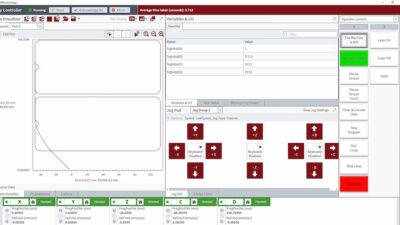What you don’t find out now can sneak up on you later. That’s why it’s critically important to ask system integrators the right questions before partnering on an automation project. To help with this challenge, Control Engineering asked its System Integrator of the Year award winners to reveal the questions their best clients ask during the process of selecting an integrator,...
Sidebars: The best of system integration System Integration eNewsletter
What you don’t find out now can sneak up on you later. That’s why it’s critically important to ask system integrators the right questions before partnering on an automation project.
To help with this challenge, Control Engineering asked its System Integrator of the Year award winners to reveal the questions their best clients ask during the process of selecting an integrator, and the answers that can ensure success.
1. Have you done this kind of work before?
Arguably the most fundamental question to ask a prospective integrator is also the most obvious. Some integrators will answer that all automation projects are alike, and from a purely technological point of view, that’s more or less true. But, all else being equal, the integrator who already understands the processes and methods used to produce the end-user’s product will be more valuable in the long run.
That’s not to say that the only acceptable candidates would be integrators who have completed exactly the same project before. “Customers need to be assured that the system integrator has the ability to complete the project, but they should be open to solutions from systems similar to theirs,” says Todd Williams, managing director of the Systems Division at The Benham Companies LLC. He suggests asking, “Have you completed a project like the one being proposed before?” and “What did you learn from that project?” Experienced integrators who already know the ins and outs of a client’s industry require less of an education to get started on the project.
Industry experience also helps the integrator when it comes time to define the scope of the project. “Clients are often rushed to pull together their requirements,” says Bob Zeigenfuse, president of Advanced Automation Inc. They may not even have enough staff to draw up a complete design themselves, “so it would be a false expectation that these requirements are a thorough reflection of their true needs,” he adds.
It then falls to the integrator to interview plant operators, users, maintenance engineers, and operations personnel to obtain the plant’s true requirements and align them with the client’s business objectives. An integrator with the background necessary to ask the right questions has an advantage over an integrator new to the client’s industry.
2. What will I get for my investment in this project, and what is it really going to cost?
Many clients look only at the capital expenditures required for an automation project, but “we want to make sure people look at the true value of the system, including the true costs of their project and its hidden costs,” says Michael Gurney, a co-owner of Concept Systems. For example, downtime can be costly, and Gurney recommends choosing an integrator who uses standardized hardware to minimize the downtime required for equipment replacement. Furthermore, “utilizing an integrator that will follow the client’s established hardware standards reduces spare parts inventories and improves maintenance personnel’s familiarity”.
Williams adds, “Sometimes system integrators will sell a software package with yearly fees or upgrade fees. Customers need to identify those costs so they can plan for the future. Many customers do not look at those fees up front, only to be forced to pay them after the project is complete.”
A particularly astute integrator can take the question of expenditures and returns one step further. He can advise the client on which automation projects to pursue. As Zeigenfuse puts it, “a good integrator can discover opportunities and turn them into useful solutions that further the client’s business objectives.”
This ability should become readily apparent during the selection process. “Look for an integrator who can help [you] leverage automation capital through standard operating procedures, standards, tools, and compliance management to gain higher value for every automation dollar,” he says.
3. Where do you see the greatest risks in this project, and how would you minimize their impact?
Risk is also a cost that clients should discuss with prospective integrators. “It is important that a system integrator understands what risks exist in a potential project. It demonstrates that they understand the scope and have accounted for the unknown issues,” says Williams.
He adds that “the highest risk items in a system integration project are the interfaces to other systems. It is important that the system integrator understands the interfaces and that everyone involved knows who is responsible.” This is especially true when custom-coded interfaces are required.
Zeigenfuse takes a slightly different perspective. “One of my bigger pet peeves associated with the execution of automation projects is the focus on the technological issues.” He advises clients to ask integrators not only about the potential technological risks, but how they would go about managing those risks and the human element. He asserts that “the processes and the people associated with the implementation are over 50% of the risk.”
Successful automation requires a long-term approach that incorporates not only the best technology, but a strategy to make the most of it.
4. What can you do for me, and what am I going to have to do for myself?
The scope of work that an integrator agrees to undertake figures into the client’s risk as well. The more responsibilities that the integrator assumes, the lower the client’s risk.
Unfortunately, not all integrators are equally capable of assuming the risks and responsibilities of a project. “Most integrators expect to provide the technical skills and domain knowledge. That’s the common denominator of what we all offer,” says Zeigenfuse. But in terms of the overall scope of work that a particular integrator can undertake, he says, “You get what you pay for.”
To illustrate that point, Zeigenfuse describes an integration value hierarchy as in the graphic. It represents the various levels of involvement that a client can expect from various kinds of integrators. “On the lower end of the totem pole are small engineering independents who just provide bodies with technical skills and domain knowledge.” Hiring individual contributors may cost less than other options, but “all the risks of success fall back on the client,” says Zeigenfuse. “Still, if you are committed to managing the risk yourself then you probably should go for staff augmentation.”
If not, Zeigenfuse recommends moving up the hierarchy when selecting an integrator. At the next level are service providers who offer not only staff augmentation, but the processes and practices for organizing the technical aspects of the project. Above that level are integrators who offer methods for managing the human element.
At the top are integrators who help their clients produce sustainable results. “They can not only get a project finished but can maximize and sustain the benefits that clients are supposed to get out of their automation investment,” notes Zeigenfuse. There are fewer integrators available at higher levels, and they tend to cost more, but they provide greater value.
5. What technologies are you proposing to use for this project?
Although it may not be the only source of risk in a project, the technology required for a successful implementation must be considered when selecting the integrator who will be entrusted with it. It’s also worthwhile to ask why an integrator is proposing a particular solution.
According to Williams, “Customers need to ask if it is the best solution for the customer or for the integrator. Some integrators select technologies because they have special pricing or they just like using that platform.” He also suggests asking the integrator how his company is affiliated with the vendor of the products to be included in the proposed solution.
Gurney suggests that a client should look for an integrator who uses leading-edge, but not proprietary technology. He believes that the end-user will be better off with modular and open architecture products. “Utilizing a standard, modular hardware platform equates to having multiple support channels. When clients buy proprietary systems, they are typically locked into that single supplier for support.”
He adds that “being able to integrate disparate hardware isn’t the biggest issue. There are a lot of hidden costs associated with mixing hardware, especially at a maintenance level. There’s always going to be a number of solutions that will solve the problem, but you want the solution that will fit your architecture.”
Unfortunately, not all technology is mutually interoperable, so some integration will always be necessary. But then, that’s what system integrators do. The trick, says Williams, is to find an integrator who can “pick a package that meets your business needs most and minimize the amount of customization that they have to do.”
Find out if a prospective integrator will settle for the a common implementation strategy that allows the system performance to degrade over time. Or, will they take a road that accelerates implementation, closes design gaps, and sustains the gains derived from the project.
Zeigenfuse takes a “holistic” approach to the selection of technology. “Every good solution is built on a foundation of standard features and functions that are built into each solution. To sustain the success of that project rather than let performance degrade, you need to take a long-term approach.” He advises selecting not only best-in-class open technology, but an entire implementation and maintenance strategy that makes the most of it. See the graphic “Holistic approach to successful automation.”
And one more: What can we expect after the project officially has been completed?
After-project considerations might not be top-of-mind when all eyes are on the start-up prize. Williams, Gurney, and Zeigenfuse all agree that planning for the future is a key element to the long-term success of an automation project, but it can be difficult to ascertain up front how well a particular integrator will handle future upgrades and enhancements.
Williams suggests asking, “What is the migration plan for future enhancements and additions to the system?” and “Are the hardware and software components open architecture, or will I have to buy certain hardware/software?” He also notes that customers need to understand that there will be an additional cost involved with future enhancements and additions. A good integrator should be able to give at least a ballpark estimate of what those future costs might be.
Zeigenfuse adds that it’s important to choose an integrator who can provide service through the automation system’s entire life-cycle. “The end point of a project is typically handing the keys over to the client. Depending on the client’s ability, the system’s performance will slowly degrade, requiring another follow-up project. We try to keep the system up and running at its maximum potential.” His strategy for “Operational effectiveness” is detailed in the graphic.
Author Information
Vance VanDoren is consulting editor to Control Engineering. Reach him at [email protected] .
The best of system integration
Find the system integrator with the skills you need in the Control Engineering Automation Integrator Guide, a December 2006 supplement. There, learn more about “System Integration at its Best” and our three award winners:
Concept Systems (winner in the category of annual revenue up to $10 million)—
Advanced Automation ($10 – $50 M annual revenue)—
The Benham Companies LLC (over $50 M annual revenue)—
System Integration eNewsletter
If you are a system integrator or work regularly with them, sign up for the monthly Control Engineering eNewsletter on System Integration. It’s free, and delivered right to your desktop or Blackberry. It covers SI news and new products including Ethernet, wireless, and other industrial networks; enclosures, connectors, wiring, and other control components; power protection and control products, and more. Sign up at



